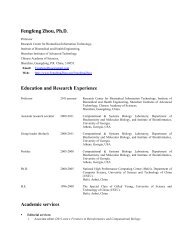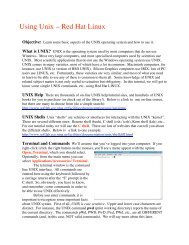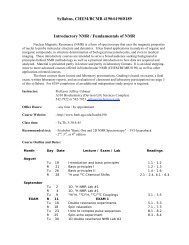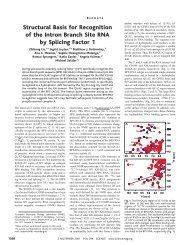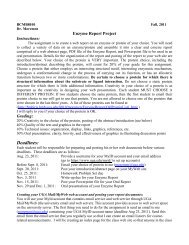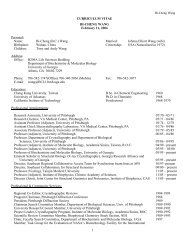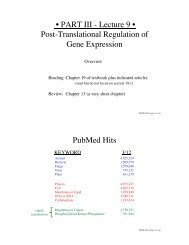Review: History of the Amyloid Fibril - Biochemistry and Molecular ...
Review: History of the Amyloid Fibril - Biochemistry and Molecular ...
Review: History of the Amyloid Fibril - Biochemistry and Molecular ...
Create successful ePaper yourself
Turn your PDF publications into a flip-book with our unique Google optimized e-Paper software.
Journal <strong>of</strong> Structural Biology 130, 88–98 (2000)<br />
doi:10.1006/jsbi.2000.4221, available online at http://www.idealibrary.com on<br />
<strong>Review</strong>: <strong>History</strong> <strong>of</strong> <strong>the</strong> <strong>Amyloid</strong> <strong>Fibril</strong><br />
Jean D. Sipe* ,1 <strong>and</strong> Alan S. Cohen<br />
*Center for Scientific <strong>Review</strong>, National Institutes <strong>of</strong> Health, Be<strong>the</strong>sda, Maryl<strong>and</strong> 20892; <strong>and</strong> †<strong>Amyloid</strong> Program,<br />
Boston University School <strong>of</strong> Medicine, Boston, Massachusetts 02118<br />
Rudolph Virchow, in 1854, introduced <strong>and</strong> popularized<br />
<strong>the</strong> term amyloid to denote a macroscopic<br />
tissue abnormality that exhibited a positive iodine<br />
staining reaction. Subsequent light microscopic<br />
studies with polarizing optics demonstrated <strong>the</strong> inherent<br />
birefringence <strong>of</strong> amyloid deposits, a property<br />
that increased intensely after staining with<br />
Congo red dye. In 1959, electron microscopic examination<br />
<strong>of</strong> ultrathin sections <strong>of</strong> amyloidotic tissues<br />
revealed <strong>the</strong> presence <strong>of</strong> fibrils, indeterminate in<br />
length <strong>and</strong>, invariably, 80 to 100 Å in width. Using<br />
<strong>the</strong> criteria <strong>of</strong> Congophilia <strong>and</strong> fibrillar morphology,<br />
20 or more biochemically distinct forms <strong>of</strong> amyloid<br />
have been identified throughout <strong>the</strong> animal<br />
kingdom; each is specifically associated with a<br />
unique clinical syndrome. <strong>Fibril</strong>s, also 80 to 100 Å in<br />
width, have been isolated from tissue homogenates<br />
using differential sedimentation or solubility. X-ray<br />
diffraction analysis revealed <strong>the</strong> fibrils to be ordered<br />
in <strong>the</strong> beta pleated sheet conformation, with<br />
<strong>the</strong> direction <strong>of</strong> <strong>the</strong> polypeptide backbone perpendicular<br />
to <strong>the</strong> fibril axis (cross beta structure). Because<br />
<strong>of</strong> <strong>the</strong> similar dimensions <strong>and</strong> tinctorial properties<br />
<strong>of</strong> <strong>the</strong> fibrils extracted from amyloid-laden<br />
tissues <strong>and</strong> amyloid fibrils in tissue sections, <strong>the</strong>y<br />
have been assumed to be identical. However, <strong>the</strong><br />
spatial relationship <strong>of</strong> proteoglycans <strong>and</strong> amyloid P<br />
component (AP), common to all forms <strong>of</strong> amyloid, to<br />
<strong>the</strong> putative protein only fibrils in tissues, has been<br />
unclear. Recently, it has been suggested that, in<br />
situ, amyloid fibrils are composed <strong>of</strong> proteoglycans<br />
<strong>and</strong> AP as well as amyloid proteins <strong>and</strong> thus resemble<br />
connective tissue micr<strong>of</strong>ibrils. Chemical <strong>and</strong><br />
physical definition <strong>of</strong> <strong>the</strong> fibrils in tissues will be<br />
needed to relate <strong>the</strong> in vitro properties <strong>of</strong> amyloid<br />
The opinions contained herein do not necessarily represent<br />
those <strong>of</strong> <strong>the</strong> Department <strong>of</strong> Health <strong>and</strong> Human Services or <strong>the</strong><br />
National Institutes <strong>of</strong> Health.<br />
1 To whom correspondence should be addressed at Center for<br />
Scientific <strong>Review</strong>, National Institutes <strong>of</strong> Health, 6701 Rockledge<br />
Drive, Room 4106, MSC 7814, Be<strong>the</strong>sda, MD 20892. Fax: 301-<br />
480-2644. E-mail: sipej@csr.nih.gov.<br />
1047-8477/00 $35.00<br />
Copyright © 2000 by Academic Press<br />
All rights <strong>of</strong> reproduction in any form reserved.<br />
Received December 6, 1999, <strong>and</strong> in revised form January 19, 2000<br />
88<br />
protein fibrils to <strong>the</strong> pathogenesis <strong>of</strong> amyloid fibril<br />
formation in vivo. © 2000 Academic Press<br />
Key Words: amyloid fibril; amyloid protein; amyloidosis;<br />
electron microscopy; history<br />
ORIGIN OF THE TERM AMYLOID<br />
The term amyloid was introduced in 1854 by <strong>the</strong><br />
German physician scientist Rudolph Virchow (reviewed<br />
by Cohen, 1986). Utilizing <strong>the</strong> best scientific<br />
methodology <strong>and</strong> medical knowledge <strong>of</strong> <strong>the</strong> time,<br />
Virchow used iodine to stain cerebral corpora amylacea<br />
that had an abnormal macroscopic appearance.<br />
The macroscopic appearance <strong>of</strong> <strong>the</strong> brain tissue<br />
was similar to previous descriptions <strong>of</strong> o<strong>the</strong>r<br />
tissues, perhaps as early as 1639, as lardaceous<br />
liver, waxy liver, <strong>and</strong> spongy <strong>and</strong> “white stone” containing<br />
spleens (Fig. 1). When Virchow discovered<br />
that <strong>the</strong> corpora amylacea stained pale blue on<br />
treatment with iodine, <strong>and</strong> violet upon <strong>the</strong> subsequent<br />
addition <strong>of</strong> sulfuric acid, he concluded that <strong>the</strong><br />
substance underlying <strong>the</strong> evident macroscopic abnormality<br />
was cellulose <strong>and</strong> gave it <strong>the</strong> name amyloid,<br />
derived from <strong>the</strong> Latin amylum <strong>and</strong> <strong>the</strong> Greek<br />
amylon (reviewed by Cohen, 1986). At <strong>the</strong> time, <strong>the</strong><br />
distinction between starch <strong>and</strong> cellulose, as related<br />
to <strong>the</strong> separation <strong>of</strong> <strong>the</strong> plant <strong>and</strong> animal kingdoms,<br />
was unclear. From subsequent literature (reviewed<br />
by Cohen, 1986), Virchow evidently considered <strong>the</strong><br />
amyloid substance to be starch, although <strong>the</strong>re was<br />
confusion as to whe<strong>the</strong>r amyloid denotes cellulose or<br />
starch. When, in 1859, Friedreich <strong>and</strong> Kekule (reviewed<br />
by Cohen, 1986) demonstrated both <strong>the</strong> presence<br />
<strong>of</strong> protein in a “mass” <strong>of</strong> amyloid <strong>and</strong> <strong>the</strong> apparent<br />
absence <strong>of</strong> carbohydrate based on <strong>the</strong> high<br />
nitrogen content, attention was shifted to <strong>the</strong> study<br />
<strong>of</strong> amyloid first as a protein <strong>and</strong> later as a class <strong>of</strong><br />
proteins, with a propensity to undergo changes in<br />
conformation that result in fibril formation.<br />
During <strong>the</strong> 19th <strong>and</strong> early 20th centuries, investigations<br />
on <strong>the</strong> nature <strong>of</strong> amyloid evolved from <strong>the</strong><br />
macroscopic observations <strong>of</strong> Virchow <strong>and</strong> contempo-
REVIEW: HISTORY OF THE AMYLOID FIBRIL<br />
FIG. 1. <strong>Amyloid</strong> deposits at low magnification; (a) attributed to Frerichs, 1862; (b) polarization microscopy <strong>of</strong> Congo red-stained nerve<br />
biopsy from patient with ATTR, V30M; original magnification, 6.3; (c) polarization microscopy <strong>of</strong> Congo red-stained heart tissue, original<br />
magnification, 16.<br />
89
90 REVIEW: SIPE AND COHEN<br />
raries (Fig. 1) to classifications <strong>of</strong> clinical symptoms<br />
(Table I). The term amyloid has been used to describe<br />
specific macroscopic abnormalities on autopsy<br />
<strong>of</strong> body organs <strong>and</strong> tissues <strong>of</strong> patients afflicted with<br />
a variety <strong>of</strong> clinical syndromes that were first classified<br />
as idiopathic (primary) or myeloma-associated,<br />
acquired (secondary), local, hereditary, endocrine<br />
associated, <strong>and</strong> amyloid associated with aging<br />
(Table I). While introducing <strong>the</strong> term amyloid is not<br />
one <strong>of</strong> Virchow’s widely known achievements, this<br />
distinguished scientist <strong>and</strong> advocate for public<br />
TABLE I<br />
Clinical Classification <strong>of</strong> <strong>Amyloid</strong>osis<br />
Systemic amyloidosis<br />
Primary or myeloma associated amyloidosis<br />
Secondary or reactive amyloidosis<br />
Hered<strong>of</strong>amilial amyloidosis<br />
Localized (organ-limited) amyloidosis<br />
Endocrine organ or tissue<br />
“Senile” plaques, brain<br />
Cardiovascular limited (“senile” cardiac)<br />
Lichen amyloidosis (skin)<br />
FIG. 1—Continued<br />
health’s use <strong>of</strong> a unifying nomenclature has led to a<br />
fascinating field <strong>of</strong> biomedical research.<br />
MICROSCOPIC STUDIES OF AMYLOID STRUCTURE<br />
Our underst<strong>and</strong>ing <strong>of</strong> amyloid structure has advanced<br />
with <strong>the</strong> available technology. Thus, investigators<br />
began to utilize, as <strong>the</strong>y became available,<br />
light microscopy <strong>and</strong> histopathologic dyes such as<br />
thi<strong>of</strong>lavin <strong>and</strong> Congo red. Initially, <strong>the</strong>y concluded<br />
that amyloid <strong>of</strong> a variety <strong>of</strong> sources was structurally<br />
amorphous. However, subsequent polarization light<br />
microscopic studies (Divry <strong>and</strong> Florkin, 1927) demonstrated<br />
that unstained <strong>and</strong> Congo red-stained accumulations<br />
<strong>of</strong> amyloid in a variety <strong>of</strong> tissues exhibited<br />
positive birefringence with respect to <strong>the</strong> long<br />
axis <strong>of</strong> <strong>the</strong> deposits. Thus, Congo red staining imparts<br />
a marked anisotropy to <strong>the</strong> inherent birefringence<br />
exhibited by amyloid fibrils in situ (Missmahl<br />
<strong>and</strong> Hartwig, 1953). Congophilia with apple green<br />
birefringence was <strong>the</strong> first criterion <strong>of</strong> amyloid to be<br />
adopted (Fig. 2).<br />
The possibility <strong>of</strong> an ordered submicroscopic<br />
structure, as indicated by <strong>the</strong> birefringence associated<br />
with amyloid deposits, led Cohen <strong>and</strong> col-
REVIEW: HISTORY OF THE AMYLOID FIBRIL<br />
FIG. 2. (a) Congo red-stained amyloidotic uterus. (b) Birefringence <strong>of</strong> section A showing <strong>the</strong> vascular amyloid <strong>and</strong> amyloid in <strong>the</strong><br />
muscle wall.<br />
91
92 REVIEW: SIPE AND COHEN<br />
FIG. 3. An electron micrograph <strong>of</strong> amyloid fibrils in section <strong>of</strong> human amyloidotic spleen (after Shirahama <strong>and</strong> Cohen, 1967). The<br />
fibrils are arranged in r<strong>and</strong>om array <strong>and</strong> are nonbranching. The measurements <strong>of</strong> <strong>the</strong> width <strong>of</strong> individual fibrils show moderate variation,<br />
with <strong>the</strong> 100-Å width most common (dark arrows), but 200–300 width also observable (open arrows). The section was stained with uranyl<br />
acetate <strong>and</strong> lead citrate <strong>and</strong> photographed 100 000 original magnification. Reproduced from The Journal <strong>of</strong> Cell Biology, 1967, Vol. 33,<br />
pp. 679–708, by copyright permission <strong>of</strong> The Rockefeller University Press.<br />
leagues to undertake electron microscopic studies <strong>of</strong><br />
human primary <strong>and</strong> secondary amyloid tissues as<br />
well as experimental amyloid (Cohen <strong>and</strong> Calkins,<br />
1959). Their first study clearly demonstrated that<br />
all forms <strong>of</strong> amyloid studied exhibit a comparable<br />
fibrillar ultrastructure in fixed tissue sections. In<br />
<strong>the</strong>ir initial study, Cohen <strong>and</strong> Calkins analyzed sections<br />
<strong>of</strong> amyloidotic tissues from rabbit with caseininduced<br />
amyloidosis (now known to be amyloid A<br />
(AA)); skin biopsy from a patient with clinically defined<br />
primary amyloidosis (now known to be AL<br />
amyloid); <strong>and</strong> kidney <strong>of</strong> a patient with amyloidosis <strong>of</strong><br />
parenchymal organs, i.e., spleen liver <strong>and</strong> kidney<br />
(now known to be AA amyloid). It has been amply<br />
confirmed (reviewed by Cohen et al., 1982) that amyloid<br />
deposits <strong>of</strong> diverse origins in humans <strong>and</strong> animals<br />
exhibit a similar, fibrillar submicroscopic<br />
structure: bundles <strong>of</strong> straight, rigid fibrils ranging in<br />
width from 60 to 130 Å (average 75 to 100 Å) <strong>and</strong> in<br />
length from 1000 to 16,000 Å (Fig. 3). The fibrillar<br />
morphology, upon analysis <strong>of</strong> negatively stained tissue<br />
sections by electron microscopy, was adopted as<br />
<strong>the</strong> second criterion by which amyloid is defined.<br />
In <strong>the</strong>ir original paper, Cohen <strong>and</strong> Calkins<br />
suggested that human <strong>and</strong> animal amyloid possess<br />
a beaded structure. Gueft <strong>and</strong> Ghidoni (1963)<br />
suggested that amyloid fibrils are double, with<br />
an intrafibrillar space (25 Å) approximately equal<br />
FIG. 4. (a) <strong>Amyloid</strong> fibrils from human amyloidotic spleen isolated by homogenization in physiological saline followed by sucrose gradient<br />
centrifugation. Shadowed with platinum–palladium, original magnification 70 000. (b) Sucrose gradient fraction negatively stained with<br />
uranyl acetate. The amyloid fibrils usually consist <strong>of</strong> two filaments aggregated side by side. The fibrils twist occasionally (arrow). The<br />
terminations <strong>of</strong> <strong>the</strong> fibrils are smooth <strong>and</strong> rounded (circle). Original magnification 200 000. (c) <strong>Amyloid</strong> fibril fraction prior to sucrose gradient<br />
centrifugation, negatively stained with phosphotungstic acid after 5 min sonication. Both amyloid fibrils (F) <strong>and</strong> amyloid P component attached<br />
to fibrils as stacks <strong>of</strong> pentamers (R) or as individual pentamers (P) are visible (after Shirahama <strong>and</strong> Cohen, 1967). Reproduced from The Journal<br />
<strong>of</strong> Cell Biology, 1967, Vol. 33, pp. 679–708, by copyright permission <strong>of</strong> The Rockefeller University Press.
REVIEW: HISTORY OF THE AMYLOID FIBRIL<br />
93
94 REVIEW: SIPE AND COHEN<br />
to <strong>the</strong> diameter <strong>of</strong> each component (25 Å). Terry<br />
<strong>and</strong> colleagues (Terry et al., 1964), studying human<br />
cerebral amyloid in <strong>the</strong> senile plaque <strong>of</strong><br />
Alzheimer’s disease, reported that <strong>the</strong> fibrils<br />
were 70–90 Å in width <strong>and</strong> had a triple density,<br />
indicating a hollow center. Shirahama <strong>and</strong><br />
Cohen (1967) carried out extensive high-resolution<br />
studies <strong>of</strong> <strong>the</strong> amyloid fibril in tissues, <strong>and</strong><br />
from <strong>the</strong>se <strong>and</strong> o<strong>the</strong>r studies reviewed by Cohen et<br />
al. (1982), a consensus amyloid fibril structure<br />
was described, in which two ultrastructural features<br />
comprised <strong>the</strong> subunit structure <strong>of</strong> <strong>the</strong> amyloid<br />
fibril in vivo. A filamentous subunit structure,<br />
25–35 Å in diameter, longitudinally constitutes<br />
<strong>the</strong> 75- to 100-Å-wide amyloid fibril. Two or more<br />
such subunit filaments, which cross each o<strong>the</strong>r<br />
occasionally, constitute <strong>the</strong> amyloid fibril in situ<br />
(Fig. 3).<br />
IN VITRO STUDIES OF AMYLOID FIBRIL PROTEINS<br />
The identification <strong>of</strong> a fibril associated with <strong>the</strong><br />
tinctorial properties <strong>of</strong> amyloid provided a basis<br />
upon which amyloid fibrils could be isolated from<br />
tissues. Initial isolation methods, based on a gentle<br />
physical separation, homogenization in saline, followed<br />
by low-speed centrifugation, yielded a layer <strong>of</strong><br />
FIG. 4—Continued<br />
fibrils that was not present in sedimentation pellets<br />
<strong>of</strong> normal tissues (Cohen <strong>and</strong> Calkins, 1964). When<br />
stained with Congo red, <strong>the</strong> fibril layer demonstrated<br />
green birefringence with polarizing optics.<br />
Shadow casting or negative staining defined <strong>the</strong> diameter<br />
<strong>of</strong> <strong>the</strong> isolated amyloid fibril as 75–100 Å.<br />
Filamentous subunits <strong>of</strong> 25–35 Å are arranged along<br />
<strong>the</strong> long axis <strong>of</strong> <strong>the</strong> fibril in a slow twist. <strong>Amyloid</strong><br />
fibrils isolated from tissues <strong>and</strong> organs by physical<br />
separation, using sucrose gradient centrifugation<br />
(Shirahama <strong>and</strong> Cohen, 1967), showed no remarkable<br />
differences in morphology from those tissues<br />
using <strong>the</strong> two criteria <strong>of</strong> Congophilia/green birefringence<br />
<strong>and</strong> fibrillar structure (Fig. 4). The similarities<br />
in dimensions <strong>and</strong> morphology between isolated<br />
protein fibrils <strong>and</strong> amyloid fibrils in tissues has led<br />
to <strong>the</strong> widely held view that <strong>the</strong> proteinaceous fibrils<br />
studied in vitro over <strong>the</strong> past 20 years are biochemically<br />
<strong>and</strong> structurally identical to <strong>the</strong> amyloid<br />
fibrils observed in tissues.<br />
However, this view has not taken into account <strong>the</strong><br />
widespread immunohistochemical observation that<br />
o<strong>the</strong>r components <strong>of</strong> amyloid deposits in tissues do<br />
not form fibrils in vitro, but are invariably associated<br />
with all clinical/biochemical types <strong>of</strong> amyloid.<br />
These nonfibrillar components <strong>of</strong> amyloid include
TABLE II<br />
Proteins Associated with <strong>Amyloid</strong> Deposits in Humans<br />
Pathophysiology<br />
<strong>Fibril</strong> precursor<br />
(kDa)<br />
Immunity/<br />
inflammation<br />
AL Immunoglobulin<br />
light chain (23)<br />
AH Immunoglobulin<br />
heavy chain (?)<br />
AA Serum amyloid A<br />
(12)<br />
<strong>Fibril</strong> protein<br />
(kDa)<br />
Variable region or<br />
fragment (5–23)<br />
(?)<br />
<strong>Amyloid</strong> A (5–10)<br />
A 2M 2-Microglobulin (12) 2-Microglobulin<br />
(12)<br />
ACys Cystatin C (13) Cystatin C<br />
fragment (12)<br />
ALys Lysozyme (14) Lysozyme (14)<br />
AFibA Fibrinogen (66) Fibrinogen <br />
fragment (11-P3)<br />
Endocrine<br />
hormones<br />
AIAPP Islet amyloid<br />
polypeptide (9)<br />
AANF Atrial natriuretic<br />
factor<br />
Islet amyloid<br />
polypeptide<br />
fragment (4)<br />
Atrial natriuretic<br />
factor fragment<br />
(4)<br />
ACal Procalcitonin Calcitonin<br />
fragment (3–4)<br />
APro Prolactin (?)<br />
AIns<br />
Transport<br />
molecules<br />
Insulin (porcine,<br />
iatrogenic (6)<br />
Insulin (6)<br />
ATTR Transthyretin (14) Transthyretin,<br />
intact/fragment<br />
(5–14)<br />
AApoAI Apolipoprotein AI Apolipoprotein AI<br />
(28)<br />
fragment (9–11)<br />
ALac<br />
Nervous system<br />
Lact<strong>of</strong>errin (?)<br />
A A protein precursor<br />
(110–135)<br />
A (4–5)<br />
APrP Prion protein Prion protein<br />
Cell motility<br />
(30–35)<br />
fragment (27–30)<br />
AGel Gelsolin (80–90) Gelsolin fragment<br />
(9–11)<br />
serum amyloid P component; heparan sulfate proteoglycans;<br />
<strong>and</strong> apolipoprotein E, which is associated<br />
with a number <strong>of</strong> types <strong>of</strong> amyloid, including<br />
<strong>the</strong> A deposits <strong>of</strong> Alzheimer’s disease.<br />
Although <strong>the</strong> early isolation <strong>of</strong> amyloid fibrils<br />
from tissues employed differential centrifugation,<br />
after Pras introduced <strong>the</strong> water extraction method,<br />
(Pras et al., 1968), <strong>the</strong> method has been almost universally<br />
used for extraction <strong>of</strong> almost all biochemical<br />
types <strong>of</strong> amyloid, except A <strong>and</strong> APrP (Selkoe <strong>and</strong><br />
Abraham, 1986; Prusiner <strong>and</strong> DeArmond, 1995).<br />
With <strong>the</strong> low ionic strength Pras method, amyloid<br />
REVIEW: HISTORY OF THE AMYLOID FIBRIL<br />
fibrils are separated from all proteins soluble in<br />
physiological saline by extraction <strong>of</strong> homogenates <strong>of</strong><br />
amyloid-laden tissues with physiological saline followed<br />
by differential centrifugation. Then, amyloid<br />
fibrils are separated from o<strong>the</strong>r saline-insoluble tissue<br />
proteins by suspension in water. The isolated<br />
protein fibrils, insoluble in physiologic saline, exhibit<br />
Congophilia <strong>and</strong> green birefringence <strong>and</strong> are<br />
80 to 100 Å in width.<br />
The insoluble protein fibrils, extracted from tissues<br />
laden with amyloid fibrils, can be solubilized<br />
<strong>and</strong> size fractionated by gel filtration in denaturing<br />
agents, such as guanidine hydrochloride. This technological<br />
advance made possible <strong>the</strong> biochemical era<br />
<strong>of</strong> amyloid studies. Amino acid sequence determination<br />
<strong>of</strong> solubilized, denatured amyloid fibril proteins<br />
quickly led to <strong>the</strong> recognition that a biochemically<br />
unique protein was associated with each <strong>of</strong> <strong>the</strong> clinical<br />
syndromes (Tables I <strong>and</strong> II). Since 1970, <strong>the</strong><br />
number <strong>of</strong> biochemically distinct proteins, isolated<br />
from species throughout <strong>the</strong> animal kingdom, that<br />
satisfy <strong>the</strong> three criteria for amyloid is approaching<br />
20 (Table II, Sipe, 1992).<br />
Studies from <strong>the</strong> Benditt <strong>and</strong> Glenner laboratories<br />
provided <strong>the</strong> first indication <strong>of</strong> <strong>the</strong> biochemical heterogeneity<br />
<strong>of</strong> amyloid. Glenner <strong>and</strong> co-workers<br />
(1971a) reported, on <strong>the</strong> basis <strong>of</strong> amino acid sequence<br />
analysis, that primary amyloidosis (now<br />
known as AL, but initially termed amyloid B by <strong>the</strong><br />
Benditt laboratory (Benditt, 1976)) is <strong>the</strong> result <strong>of</strong><br />
<strong>the</strong> deposition <strong>of</strong> fragments <strong>of</strong> immunoglobulin light<br />
chains. Benditt <strong>and</strong> colleagues identified, on <strong>the</strong> basis<br />
<strong>of</strong> amino acid sequence analysis <strong>of</strong> fibrils isolated<br />
from tissues <strong>of</strong> patients with chronic <strong>and</strong> recurrent<br />
acute inflammatory diseases (secondary amyloidosis),<br />
a protein termed amyloid A (Benditt et al.,<br />
1971). The existence <strong>of</strong> a third biochemical class <strong>of</strong><br />
amyloid protein was revealed when Costa et al.<br />
(1978) <strong>and</strong> Skinner <strong>and</strong> Cohen (1981) reported that<br />
prealbumin, now known as transthyretin, is <strong>the</strong><br />
fibril protein associated with familial amyloid polyneuropathy.<br />
Subsequent biochemical analyses, including<br />
amino acid sequencing, led to <strong>the</strong> identification<br />
<strong>of</strong> fragments (usually) <strong>of</strong> about 20 normally<br />
soluble proteins deposited in a specific anatomic pattern<br />
associated with specific clinical manifestation<br />
<strong>of</strong> disease (Table II). In some cases, only a single<br />
organ <strong>of</strong> <strong>the</strong> body is affected, such as <strong>the</strong> pancreas in<br />
diabetes or <strong>the</strong> brain in Alzheimer’s disease. In<br />
o<strong>the</strong>r cases, termed systemic amyloidoses, amyloid<br />
fibrils are deposited in multiple organs <strong>and</strong> tissues<br />
<strong>of</strong> <strong>the</strong> body <strong>and</strong> are thought to be derived from<br />
circulating plasma protein precursors (Sipe, 1992,<br />
1994).<br />
Today, amyloid is known to be a large biochemically<br />
<strong>and</strong> clinically heterogenous group <strong>of</strong> disorders<br />
95
96 REVIEW: SIPE AND COHEN<br />
<strong>of</strong> protein folding. Investigations <strong>of</strong> amyloid have led<br />
to <strong>the</strong> identification <strong>of</strong> previously unknown peptides<br />
<strong>and</strong> proteins implicated in a large number <strong>of</strong> important<br />
life processes. These proteins include <strong>the</strong> amyloid<br />
A protein <strong>and</strong> its precursor, <strong>the</strong> cytokine-regulated<br />
serum amyloid A (SAA); more than 70<br />
transthyretin (TTR) variants; <strong>the</strong> cerebral amyloid <br />
protein, A, <strong>and</strong> its precursor protein APP; <strong>the</strong><br />
previously unrecognized diabetes-associated islet<br />
amyloid polypeptide (IAPP); <strong>and</strong> prion proteins that<br />
cause scrapie <strong>and</strong> o<strong>the</strong>r neurodegenerative diseases<br />
(APrP) (Cohen, 1967; Glenner, 1980; Sipe, 1992;<br />
Westermark et al., 1996; Benson <strong>and</strong> Uemechi,<br />
1996; Prusiner <strong>and</strong> DeArmond, 1995).<br />
X-ray diffraction analyses <strong>of</strong> isolated amyloid protein<br />
fibrils (Bonar et al., 1969; Glenner et al., 1974;<br />
Sunde <strong>and</strong> Blake, 1998) revealed that all proteinaceous<br />
amyloid fibrils were ordered in secondary<br />
structure, with <strong>the</strong> polypeptide backbone assuming<br />
<strong>the</strong> beta pleated sheet conformation <strong>and</strong> oriented<br />
perpendicular to <strong>the</strong> fibril axis. It is particularly<br />
noteworthy that, in <strong>the</strong> case <strong>of</strong> TTR, which is<br />
present in <strong>the</strong> vitreous fluid <strong>of</strong> FAP patients as well<br />
as throughout <strong>the</strong> body, <strong>the</strong> structure <strong>of</strong> <strong>the</strong> TTR<br />
fibril from <strong>the</strong> vitreous (for which <strong>the</strong> Pras extraction<br />
method would not have to be used) <strong>and</strong> <strong>the</strong> TTR<br />
fibril extracted from kidney (for which <strong>the</strong> Pras<br />
method or a modification <strong>of</strong> it would be used) are<br />
identical (Inouye et al., 1998).<br />
The association <strong>of</strong> <strong>the</strong> pentraxin SAP with tissue<br />
amyloid deposits was revealed by electron microscopic<br />
studies <strong>of</strong> fractions <strong>of</strong> tissue homogenates<br />
that had been separated on <strong>the</strong> basis <strong>of</strong> solubility<br />
<strong>and</strong> sedimentation under conditions <strong>of</strong> decreasing<br />
ionic strength (reviewed by Cohen et al., 1982). It<br />
soon became apparent that, in addition to <strong>the</strong> fibrilrich<br />
fraction, ano<strong>the</strong>r, pentagonal, particle, composed<br />
<strong>of</strong> five identical globular subunits, was invariably<br />
associated with amyloid deposits in tissues. The<br />
pentagonal component (P component) was identified<br />
immunochemically by Cathcart <strong>and</strong> co-workers<br />
(1965) as an alpha globulin. Bladen <strong>and</strong> co-workers<br />
(1966), using a differential centrifugation technique,<br />
identified a small pentagonal structure about 90 Å<br />
in diameter (Fig. 4c). Subsequent studies (reviewed<br />
by Pepys et al., 1997) led to <strong>the</strong> identification <strong>of</strong> a<br />
circulating blood protein nearly if not identical to<br />
<strong>the</strong> tissue protein. That blood protein is now called<br />
serum amyloid P component or SAP.<br />
Despite <strong>the</strong> fact that SAP <strong>and</strong> heparan sulfate<br />
proteoglycans (HSPG) are always present in tissues<br />
with amyloid fibrils (Pepys et al., 1997; Snow <strong>and</strong><br />
Wight, 1989; Magnus <strong>and</strong> Stenstad, 1997), amyloid<br />
fibrils can be formed in vitro in <strong>the</strong>ir absence from<br />
several natural polypeptides, including insulin, glucagon,<br />
calcitonin, immunoglobulin light chains, <strong>and</strong><br />
2-microglobulin (reviewed in Sipe, 1994). <strong>Fibril</strong>s,<br />
similar in dimension <strong>and</strong> appearance to tissue-derived<br />
amyloid proteins, have also have been formed<br />
from syn<strong>the</strong>tic peptides corresponding to part or all<br />
<strong>of</strong> AA, A, <strong>and</strong> IAPP. <strong>Amyloid</strong>ogenic polypeptides<br />
can be influenced by heparin to assume <strong>the</strong> beta<br />
pleated sheet ra<strong>the</strong>r than <strong>the</strong> alpha helical conformation<br />
(McCubbin et al., 1988). Studies <strong>of</strong> syn<strong>the</strong>tic<br />
peptides led to <strong>the</strong> identification <strong>of</strong> amyloidogenic<br />
sequences in some precursors, such as AA, A, <strong>and</strong><br />
IAPP, but not in o<strong>the</strong>rs, such as AL <strong>and</strong> ATTR<br />
(reviewed in Sipe, 1994). Some amyloidogenic precursors,<br />
such as TTR <strong>and</strong> immunoglobulin light<br />
chains, are predisposed to fibril formation by structural<br />
changes (amino acid substitutions) in disparate<br />
parts <strong>of</strong> <strong>the</strong> polypeptide, changes that promote<br />
unfolding. O<strong>the</strong>rs, such as A, AA, <strong>and</strong> AIAPP precursor,<br />
contain contiguous regions <strong>of</strong> amino acids<br />
that predispose to amyloid fibril formation. Recently,<br />
amyloid fibrils were generated by acid <strong>and</strong><br />
heat denaturation <strong>of</strong> monellin, a sweet tasting plant<br />
protein (Konno et al., 1999). De novo amyloid proteins<br />
have been generated from designed combinatorial<br />
libraries, in which all sequences were designed<br />
to share an identical pattern <strong>of</strong> alternating<br />
polar <strong>and</strong> nonpolar residues, <strong>and</strong> <strong>the</strong> side chains<br />
were varied combinatorially (West et al., 1999). The<br />
resultant aggregates have fibrillar morphology, are<br />
Congophilic, <strong>and</strong> assume <strong>the</strong> beta pleated sheet secondary<br />
structure. The X-ray diffraction patterns <strong>of</strong><br />
amyloid fibrils prepared in vitro <strong>and</strong> those extracted<br />
from tissues are similar (Glenner et al., 1974). Apparently,<br />
<strong>the</strong> formation <strong>of</strong> proteinaceous amyloid<br />
fibrils is <strong>the</strong> result <strong>of</strong> a combination <strong>of</strong> factors, including<br />
<strong>the</strong> primary structure <strong>of</strong> <strong>the</strong> polypeptide <strong>and</strong><br />
<strong>the</strong> <strong>the</strong>rmodynamic parameters <strong>of</strong> <strong>the</strong> environment<br />
<strong>of</strong> <strong>the</strong> polypeptide (Kelly, 1998).<br />
<strong>Fibril</strong>s indistinguishable from those isolated from<br />
tissues were created by proteolytic digestion <strong>of</strong><br />
Bence-Jones immunoglobulin light chain proteins<br />
(Glenner et al., 1971b; Linke et al., 1973; Shirahama<br />
et al., 1973). The in vitro properties <strong>of</strong> fibrillar morphology,<br />
Congophilia, <strong>and</strong> green birefringence led to<br />
<strong>the</strong> conclusion that <strong>the</strong> AL fibrils were identical to<br />
those deposited in tissues in vivo. Thus, <strong>the</strong> in vitro<br />
observation <strong>of</strong> <strong>the</strong> properties <strong>of</strong> insolubility <strong>and</strong> resistance<br />
to proteolysis led to <strong>the</strong> assumption that<br />
amyloid fibrils exhibit <strong>the</strong> same properties in vivo<br />
<strong>and</strong> in vitro <strong>and</strong> that insolubility <strong>and</strong> resistance to<br />
proteolytic clearance lead to replacement <strong>and</strong> destruction<br />
<strong>of</strong> vital organs that are clinically affected<br />
with amyloidosis.<br />
CURRENT MODEL OF AMYLOID FIBRILS IN TISSUES<br />
As evidenced by o<strong>the</strong>r reports in this volume, we<br />
are currently entering a new molecular <strong>and</strong> <strong>the</strong>ra-
peutic era <strong>of</strong> amyloid, one in which prevention or<br />
reversal <strong>of</strong> amyloid fibril formation <strong>and</strong> <strong>the</strong> ensuing<br />
pathology in <strong>the</strong> body may be anticipated. Future<br />
multidisciplinary investigations <strong>of</strong> amyloid must be<br />
based upon a clear underst<strong>and</strong>ing <strong>of</strong> how <strong>the</strong> biophysical<br />
properties <strong>of</strong> proteins isolated from organs<br />
<strong>of</strong> patients afflicted with amyloidosis relate to <strong>the</strong><br />
actual secondary structure <strong>of</strong> <strong>the</strong>se fibrils in tissues.<br />
Inoue <strong>and</strong> colleagues (Inoue et al., 1998a) have<br />
compared experimental mouse AA amyloid fibrils in<br />
situ <strong>and</strong> after isolation by <strong>the</strong> Pras method (Pras et<br />
al., 1968). On <strong>the</strong> basis <strong>of</strong> <strong>the</strong>ir observation on AA<br />
amyloid <strong>and</strong> on o<strong>the</strong>r forms, including A, 2-microglobulin,<br />
<strong>and</strong> ATTR (Inoue et al., 1999, 1998b, 1997),<br />
<strong>the</strong>y have proposed an alternative to <strong>the</strong> protein<br />
only, beta pleated sheet, prot<strong>of</strong>ilament amyloid fibril<br />
structure. Inoue, in collaboration with Kisilevsky<br />
<strong>and</strong> co-workers, has suggested that <strong>the</strong> 80- to 100-Å<br />
fibrillar structure in tissue is different from <strong>the</strong><br />
structure <strong>of</strong> isolated protein in vitro. He proposes, on<br />
<strong>the</strong> basis <strong>of</strong> high-resolution electron microscopic<br />
studies, that in tissues, <strong>the</strong> amyloid fibril core is<br />
composed <strong>of</strong> helically wound 30-Å chondroitin sulfate<br />
proteoglycan (CSPG) double tracked structures<br />
enclosing a pentamer <strong>of</strong> amyloid P component (AP).<br />
Outside <strong>the</strong> CSPG are 45- to 50-Å heparan sulfate<br />
proteoglycans, to which AA protein filaments are<br />
attached. Presumably, <strong>the</strong> filaments are ordered to<br />
account for Congophilia <strong>and</strong> o<strong>the</strong>r specific histochemical<br />
staining, although <strong>the</strong> molecular basis for<br />
Congophilia is not clearly defined. Inoue <strong>and</strong> colleagues<br />
have proposed that <strong>the</strong> protein only fibril is<br />
formed artifactually as a result <strong>of</strong> <strong>the</strong> decreased<br />
ionic strength employed as part <strong>of</strong> <strong>the</strong> Pras extraction<br />
procedure. The Inoue model would consistently<br />
incorporate <strong>the</strong> reported HSPG binding sites in SAA<br />
(reviewed by Urieli-Shoval et al., 2000) <strong>and</strong> o<strong>the</strong>r<br />
amyloid proteins as well as <strong>the</strong> consistent changes<br />
in proteoglycan syn<strong>the</strong>sis that precede amyloidogenesis<br />
(Kisilevsky <strong>and</strong> Fraser, 1997).<br />
The structure <strong>of</strong> <strong>the</strong> amyloid fibril in tissues has<br />
not been as rigorously analyzed as <strong>the</strong> protein only<br />
model <strong>of</strong> <strong>the</strong> amyloid fibril that has been derived<br />
from <strong>the</strong> past 3 decades <strong>of</strong> in vitro studies. In particular,<br />
a revisitation <strong>of</strong> <strong>the</strong> practice <strong>of</strong> isolation <strong>of</strong><br />
amyloid fibrils from tissues, using <strong>the</strong> early “gentle<br />
amyloid fractionation techniques,” is probably warranted.<br />
Future biochemical investigations will be<br />
more fruitful if heparan sulfate proteoglycan <strong>and</strong> AP<br />
content are analyzed, in addition to <strong>the</strong> major fibrilassociated<br />
protein. In particular, comparison <strong>of</strong> TTR<br />
fibrils from vitreous fluid <strong>and</strong> organs such as kidney<br />
from FAP patients, where <strong>the</strong> composition <strong>of</strong> extracellular<br />
matrix <strong>of</strong> <strong>the</strong>se tissues <strong>and</strong> <strong>the</strong> fibril isolation<br />
procedures applied to <strong>the</strong>m are distinct (Inouye<br />
REVIEW: HISTORY OF THE AMYLOID FIBRIL<br />
et al., 1998), may greatly enhance our underst<strong>and</strong>ing<br />
<strong>of</strong> <strong>the</strong> nature <strong>of</strong> amyloid fibril structure in vivo.<br />
REFERENCES<br />
Benditt, E. P. (1976) The structure <strong>of</strong> amyloid protein AA <strong>and</strong><br />
evidence for a transmissible factor in <strong>the</strong> origin <strong>of</strong> amyloidosis,<br />
in Wegelius, O., <strong>and</strong> Pasternack, A. (Eds.), <strong>Amyloid</strong>osis, pp.<br />
323–337, Academic Press, London.<br />
Benditt, E. P., Eriksen, N., Hermodson, M. A., et al. (1971) The<br />
major proteins <strong>of</strong> human <strong>and</strong> monkey amyloid substance: Common<br />
properties including unusual N-terminal amino acid sequences,<br />
FEBS Lett. 19, 169–173.<br />
Benson, M. D., Uemichi, T. (1996) Transthyretin amyloidosis,<br />
<strong>Amyloid</strong>. Int. J. Exp. Clin. Invest. 3, 44–56.<br />
Bladen, H. A., Nylen, M. U., <strong>and</strong> Glenner, G. G. (1966) The<br />
ultrastructure <strong>of</strong> human amyloid as revealed by <strong>the</strong> negative<br />
staining technique, J. Ultrastruct. Res. 14, 449–459.<br />
Bonar, L., Cohen, A. S., <strong>and</strong> Skinner, M. M. (1969) Characterization<br />
<strong>of</strong> <strong>the</strong> amyloid fibril as a cross-beta protein, Proc. Soc. Exp.<br />
Biol. Med. 131, 1373–1375.<br />
Cathcart, E. S., Comerford, F. R., <strong>and</strong> Cohen, A. S. (1965) Immunologic<br />
studies on protein extracted from human secondary<br />
amyloid, N. Eng. J. Med. 273, 143–146.<br />
Cohen, A. S. (1967) Medical progress. <strong>Amyloid</strong>osis, N. Eng. J.<br />
Med. 277, 522–530.<br />
Cohen, A. S. (1986) General introduction <strong>and</strong> a brief history <strong>of</strong> <strong>the</strong><br />
amyloid fibril, in Marrink, J., <strong>and</strong> Van Rijswijk, M. H. (Eds.),<br />
<strong>Amyloid</strong>osis, pp. 3–19, Nijh<strong>of</strong>f, Dordrecht.<br />
Cohen, A. S., Shirahama, T., <strong>and</strong> Skinner, M. (1982) Electron<br />
Microscopy <strong>of</strong> <strong>Amyloid</strong>, in Harris, J. R., (Ed.), Electron Microscopy<br />
<strong>of</strong> Proteins, Vol. 3, pp. 165–205, Academic Press, New<br />
York.<br />
Cohen, A. S., <strong>and</strong> Calkins, E. (1959) Electron microscopic observation<br />
on a fibrous component in amyloid <strong>of</strong> diverse origins,<br />
Nature 183, 1202–1203.<br />
Cohen, A. S., <strong>and</strong> Calkins, E. (1964) Isolation <strong>of</strong> amyloid fibrils<br />
<strong>and</strong> study <strong>of</strong> effect <strong>of</strong> collagenase <strong>and</strong> hyaluronidase, J. Cell<br />
Biol. 21, 481–486.<br />
Costa, P. P., Figueira, A. S., <strong>and</strong> Bravo, F. R. (1978) <strong>Amyloid</strong> fibril<br />
protein related to prealbumin in familial amyloidotic polyneuropathy,<br />
Proc. Natl. Acad. Sci. USA 75, 4499–4503.<br />
Divry, P., <strong>and</strong> Florkin, M. (1927) Sur les proprietes optiques de<br />
l’amyloide, C. R. Soc. Biol. 97, 1808–1810.<br />
Glenner, G. G. (1980) <strong>Amyloid</strong> deposits <strong>and</strong> amyloidosis. The beta<br />
fibrilloses, N. Engl. J. Med. 302, 1283–1333.<br />
Glenner, G. G., Terry, W., Harada, M., Isersky, C., <strong>and</strong> Page, D.<br />
(1971a) <strong>Amyloid</strong> fibrils proteins: pro<strong>of</strong> <strong>of</strong> homology with immunoglobulin<br />
light chains by sequence analysis, Science 172,<br />
1150–1153.<br />
Glenner, G. G., Ein, D., Eanes, E. D., Bladen, H. A., Terry, W.,<br />
<strong>and</strong> Page, D. (1971b) Creation <strong>of</strong> “<strong>Amyloid</strong>” fibrils from Bence<br />
Jones proteins in vitro, Science 174, 712–714.<br />
Glenner, G. G., Eanes, E. D., Bladen, H. A., et al. (1974) Betapleated<br />
sheet fibrils A comparison <strong>of</strong> native amyloid with syn<strong>the</strong>tic<br />
protein fibrils, J. Histochem. Cytochem. 22, 1141–1158.<br />
Gueft, B., <strong>and</strong> Ghidoni, J. J. (1963) The site <strong>of</strong> formation <strong>and</strong><br />
ultrastructure <strong>of</strong> amyloid, Am. J. Pathol. 43, 837–854.<br />
Inoue, S., Kuroiwa, M., Tan, R., <strong>and</strong> Kisilevsky, R. (1998) A high<br />
resolution ultrastructural comparison <strong>of</strong> isolated <strong>and</strong> in situ<br />
murine amyloid fibrils, <strong>Amyloid</strong>. Int. J. Exp. Clin. Invest. 5,<br />
99–110.<br />
Inoue, S., Kuroiwa, M., <strong>and</strong> Kisilevsky, R. (1999) Basement mem-<br />
97
98 REVIEW: SIPE AND COHEN<br />
branes, micr<strong>of</strong>ibrils <strong>and</strong> beta amyloid fibrillogenesis in Alzheimer’s<br />
disease: High resolution ultrastructural findings, Brain<br />
Res. Rev. 29, 218–231.<br />
Inoue, S., Kuroiwa, M., Saraiva, M. J., et al. (1998a) Ultrastructure<br />
<strong>of</strong> familial amyloid polyneuropathy amyloid fibrils: Examination<br />
with high-resolution electron microscopy, J. Struct.<br />
Biol. 124, 1–12.<br />
Inoue, S., Kuroiwa, M., Ohashi, K., et al. (1997) Ultrastructural<br />
organization <strong>of</strong> hemodialysis-associated beta(2)-microglobulin<br />
amyloid fibrils, Kidney Int. 52, 1543–1549.<br />
Inouye, H., Domingues, F. S., Damas, A. M., Saraiva, M. J.,<br />
Lundgren, E., S<strong>and</strong>gren, O., <strong>and</strong> Kirschner, D. A. (1998b) Analysis<br />
<strong>of</strong> x-ray diffraction patterns from amyloid <strong>of</strong> biopsied vitreous<br />
humor <strong>and</strong> kidney <strong>of</strong> transthyretin (TTR) Met30 familial<br />
amyloidotic polyneuropathy (FAP) patients: Axially arrayed<br />
TTR monomers constitute <strong>the</strong> prot<strong>of</strong>ilament, <strong>Amyloid</strong> Int. J.<br />
Exp. Clin. Invest. 5, 163–174.<br />
Kelly, J. W. (1998) The environmental dependency <strong>of</strong> protein<br />
folding best explains prion <strong>and</strong> amyloid diseases, Proc. Natl.<br />
Acad. Sci. USA 95, 930–932.<br />
Kisilevsky, R., <strong>and</strong> Fraser, P. E. (1997) A beta amyloidogenesis:<br />
Unique, or variation on a systemic <strong>the</strong>me? J. Crit. Rev. Biochem.<br />
Mol. 32, 361–404.<br />
Konno, T., Murata, K., <strong>and</strong> Nagayama, K. (1999) <strong>Amyloid</strong>-like<br />
aggregates <strong>of</strong> a plant protein: A case <strong>of</strong> a sweet-tasting protein,<br />
monellin, FEBS Lett. 454, 122–126.<br />
Linke, R. P., Tischendorf, F. W., Zucker-Franklin, D., et al. (1973)<br />
The formation <strong>of</strong> amyloid-like fibrils in vitro from Bence Jones<br />
proteins <strong>of</strong> <strong>the</strong> lambda I subclass, J. Immunol. 111, 24–26.<br />
Magnus, J. H., <strong>and</strong> Stenstad, T. (1997) Proteoglycans <strong>and</strong> <strong>the</strong><br />
extracellular matrix in amyloidosis, <strong>Amyloid</strong>. Int. J. Exp. Clin.<br />
Invest. 4, 121–134.<br />
McCubbin, W. D., Kay, C. M., Narindrasorasak, S., <strong>and</strong> Kisilevsky,<br />
R. (1988) Circular dichroism <strong>and</strong> fluorescence studies<br />
on two murine serum amyloid A proteins, Biochem. J. 256,<br />
775–783.<br />
Missmahl, H. P., <strong>and</strong> Hartwig, M. (1953) Polarisationsoptische<br />
untersuchungen an der amyloidsubstance, Virchows. Arch.<br />
Pathol. Anat. 324, 489–508.<br />
Pepys, M. B., Booth, D. R., Hutchinson, W. L., Gallimore, J. R.,<br />
Collins, P. M., <strong>and</strong> Hohenester, E. (1997) <strong>Amyloid</strong> P component.<br />
A critical review, <strong>Amyloid</strong>. Int. J. Exp. Clin. Invest. 4,<br />
274–295.<br />
Pras, M., Schubert, M., Zucker-Franklin, D., et al. (1968) The<br />
characterization <strong>of</strong> soluble amyloid prepared in water, J. Clin.<br />
Invest. 47, 924–933.<br />
Prusiner, S. B., <strong>and</strong> DeArmond, S. J. (1995) Prion protein amyloid<br />
<strong>and</strong> neurodegeneration, <strong>Amyloid</strong> Int. J. Exp. Clin. Invest. 2,<br />
39–65.<br />
Selkoe, D. J., <strong>and</strong> Abraham, C. R. (1986) Isolation <strong>of</strong> paired<br />
helical filaments <strong>and</strong> amyloid fibers from human brain, Methods<br />
Enzymol. 134, 388–404.<br />
Shirahama, T., Benson, M. D., Cohen, A. S., <strong>and</strong> Tanaka, A.<br />
(1973) <strong>Fibril</strong>lar assemblage <strong>of</strong> variable segments <strong>of</strong> immunoglobulin<br />
light chains: An electron microscopic study, J. Immunol.<br />
110, 21–26.<br />
Shirahama, T., <strong>and</strong> Cohen, A. S. (1967) High resolution electron<br />
microscopic analysis <strong>of</strong> <strong>the</strong> amyloid fibril. J. Cell Biol. 33,<br />
679–708.<br />
Sipe, J. D. (1992) <strong>Amyloid</strong>osis, Annu. Rev. Biochem. 61, 947–975.<br />
Sipe, J. D. (1994) <strong>Amyloid</strong>osis, in Hindmarsh, J. T., <strong>and</strong> Goldberg,<br />
D. M. (Eds.), Critical <strong>Review</strong>s in Clinical Laboratory Sciences,<br />
Vol. 31, pp. 325–354. CRC Press, Boca Raton.<br />
Skinner, M., <strong>and</strong> Cohen, A. S. (1981) The prealbumin nature <strong>of</strong><br />
<strong>the</strong> amyloid protein in familial amyloid polyneuropathy (FAP),<br />
Biochem. Biophys. Res. Commun. 99, 1326–1332.<br />
Snow, A. D., <strong>and</strong> Wight, T. N. (1989) Proteoglycans in <strong>the</strong> pathogenesis<br />
<strong>of</strong> Alzheimer’s disease <strong>and</strong> o<strong>the</strong>r amyloidosis, Neurobiol.<br />
Aging 10, 481–497.<br />
Sunde, M., <strong>and</strong> Blake, C. C. F. (1998) From <strong>the</strong> globular to <strong>the</strong><br />
fibrous state: protein structure <strong>and</strong> structural conversion in<br />
amyloid formation, Q. Rev. Biophys. 31, 1–39.<br />
Terry, R. D., Nicholas, K. G., <strong>and</strong> Weiss, M. (1964) Ultrastructural<br />
studies in Alzheimer’s presenile dementia, Am. J. Pathol.<br />
44, 269–297.<br />
Urieli-Shoval, S., Linke, R. P., <strong>and</strong> Matzner, Y. (2000) Expression<br />
<strong>and</strong> function <strong>of</strong> serum amyloid A, a major acute phase protein,<br />
in normal <strong>and</strong> disease states, Curr. Opin. Hematol. 7, 64–69.<br />
West, M. W., Wang, W. X., Patterson, J., Mancias, J. D., Beasley,<br />
J. R., <strong>and</strong> Hecht, M. H. (1999) De novo amyloid proteins from<br />
designed combinatorial libraries, Proc. Natl. Acad. Sci. USA<br />
96, 11211–11216.<br />
Westermark, P., Sletten, K., <strong>and</strong> Johnson, K. H. (1996) Ageing<br />
<strong>and</strong> amyloid fibrillogenesis: Lessons from apolipoprotein AI,<br />
transthyretin <strong>and</strong> islet amyloid polypeptide, CIBA Found.<br />
Symp. 199, 205–222.



